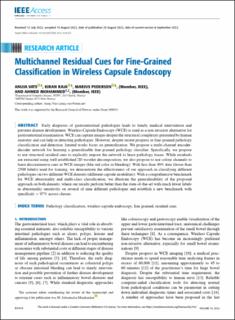Multichannel Residual Cues for Fine-Grained Classification in Wireless Capsule Endoscopy
Peer reviewed, Journal article
Published version
Permanent lenke
https://hdl.handle.net/11250/3054499Utgivelsesdato
2022Metadata
Vis full innførselSamlinger
Sammendrag
Early diagnosis of gastrointestinal pathologies leads to timely medical intervention and prevents disease development. Wireless Capsule Endoscopy (WCE) is used as a non-invasive alternative for gastrointestinal examination. WCE can capture images despite the structural complexity presented by human anatomy and can help in detecting pathologies. However, despite recent progress in fine-grained pathology classification and detection, limited works focus on generalization. We propose a multi-channel encoder-decoder network for learning a generalizable fine-grained pathology classifier. Specifically, we propose to use structural residual cues to explicitly impose the network to learn pathology traces. While residuals are extracted using well-established 2D wavelet decomposition, we also propose to use colour channels to learn discriminative cues in WCE images (like red color in bleeding). With less than 40% data (fewer than 2500 labels) used for training, we demonstrate the effectiveness of our approach in classifying different pathologies on two different WCE datasets (different capsule modalities). With a comprehensive benchmark for WCE abnormality and multi-class classification, we illustrate the generalizability of the proposed approach on both datasets, where our results perform better than the state-of-the-art with much fewer labels in abnormality sensitivity on several of nine different pathologies and establish a new benchmark with specificity >97% across classes.

